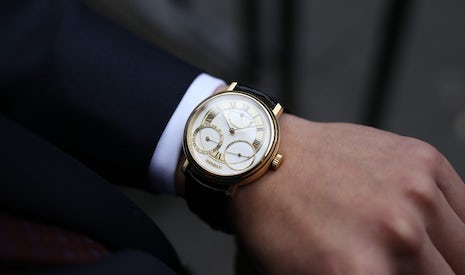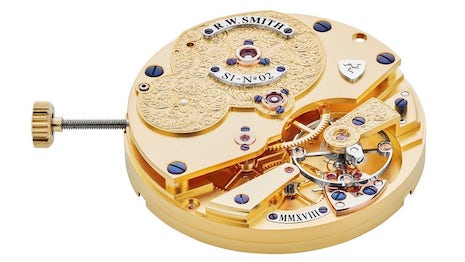 A Roger W Smith George Daniels Anniversary watch. Image credit: A Collected Man
A Roger W Smith George Daniels Anniversary watch. Image credit: A Collected Man
NEW YORK – Luxury timepieces are remarkable for their craftsmanship, style and materials, but precision is also a key part of a “perfect watch.”
Famed horologist Dr. Roger Smith spoke alongside researchers from Manchester Metropolitan University at the “Nanotechnology and The Future of Watchmaking” discussion at the Design Our Future conference on April 4. Advancements in nanotechnology are poised to take the efficiency of watches to a new level, since traditional lubricants eventually wear down and require timepiece maintenance.
“The great problem with watchmaking is oil,” Dr. Smith said. “If you can remove all the oil from a watch, you solve a lot of problems.”
The Design Our Future conference was hosted by the United Kingdom’s Department for International Trade and the British Consulate General New York.
Watchmaking science
Dr. Smith apprenticed under iconic watchmaker Dr. George Daniels before establishing the Roger W Smith studio in 2001.
Currently, Roger W Smith has an annual production of 10 watches. On the rare occasion a Roger W Smith timepiece appears on the resale market, it sells for six figures.
The watchmaker’s mentor Dr. Daniels is best remembered for creating the coaxial escapement, which eliminates the need for lubricants due to its low friction. Swiss watchmaker Omega has been using the technology in its highest-grade timepieces for the last two decades.
The mechanics inside a Roger W Smith watch. Image credit: Hodinkee
With the help of researchers at MMU, Dr. Smith is hoping to take watchmaking technology a step further with 2D nanomaterials. By creating a dry lubricated surface, a timepiece with nanomaterials would never need servicing and could keep time indefinitely.
Both the watchmaking and automotive industries are experimenting with oil-free lubricants.
“It is going to require a significant amount of rethink on the part of everyone,” said Dr. Samuel Rowley-Neale, research associate at MMU.
The team expects the initial watch with the new components to be available within the next six months.
Horologist honesty
As a well-known independent watchmaker, Dr. Smith keeps pulse on the industry as a whole.
Many luxury watchmakers have increasingly been launching tech-driven watches as consumers seek more than analog features.
Sales of smartwatches were up 54 percent in 2018, contributing to a 13 percent rise in overall watch sales throughout the year, according to data from NPD Group. While traditional timepieces accounted for more than half of sales during the year, smartwatches took the lead in the last quarter with 55 percent of all spending (see story).
“The name is totally wrong – it’s a smart device,” Dr. Smith said. “A smartwatch is really an extension of the phone I have in my pocket.”
Although Roger W Smith has found success with its limited and exclusive offerings, the luxury watchmaking industry as a whole has faced recent struggles and questions about relevancy.
However the Swiss watch industry continued its uptick in February, with luxury priced timepieces seeing the greatest growth.
Watches priced at more than 3,000 Swiss francs, even with the U.S. dollar, saw the strongest increase in both number of units and value of exports. According to data from the Federation of the Swiss Watch Industry, in total, 1.8 billion Swiss francs worth of watches were shipped, an increase of 3.4 percent year-over-year (see story).
“Fortunately I’m always bumping into people who love watches,” Dr. Smith said. “There’s always people being engaged.”

